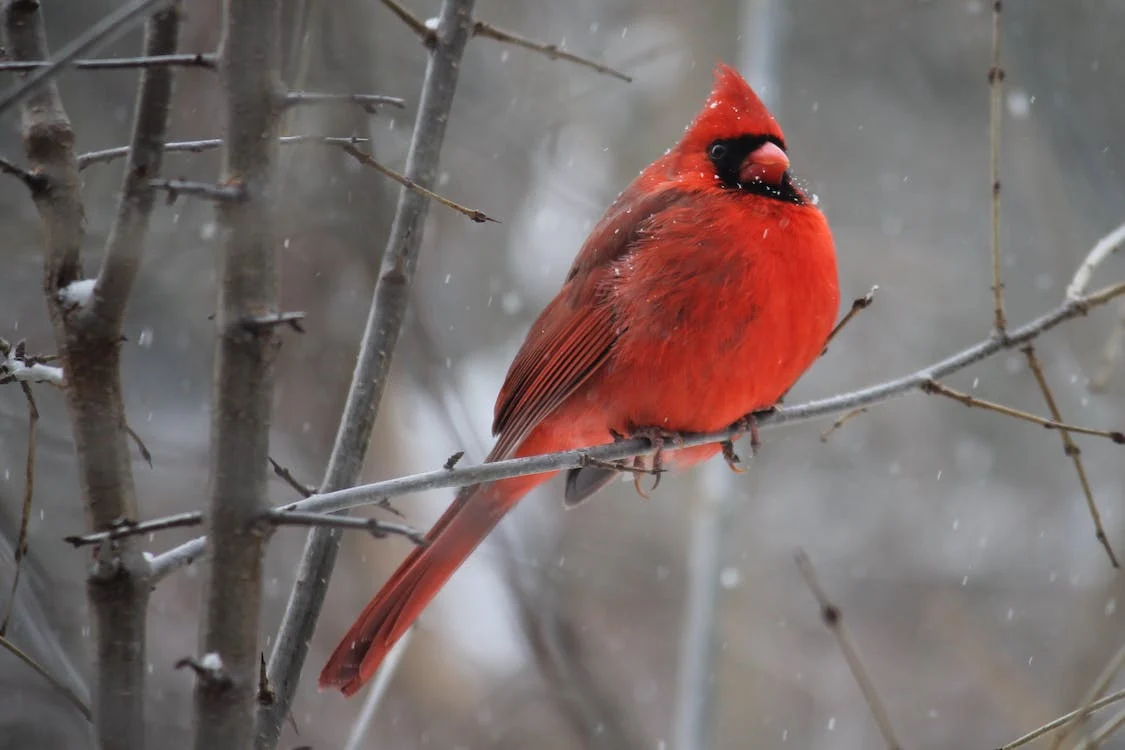
Winter can be a stark and beautiful time of year. However, with that cold, freezing weather, it’s no wonder most of the birds have migrated south!
Even so, some hardy resident birds stick around for the winter. Some northern species even migrate south to spend the winter in the northern USA and southern Canada!
When the temperatures drop, you can’t help but wonder how those birds survive the cold weather. Which species stay and which ones leave? Do all robins migrate?
There’s a lot of questions and misinformation about winter birds. See this article for the right answers and learn how winter birds thrive during the coldest time of the year!
Which are the most common winter birds?
The most common winter birds depend on where you live.
Folks who live in Alaska or other cold northern locations see Common Ravens, Northern Shrikes, Canada Jays, and some other species adapted to harsh weather.
However, in southern Canada and the northern half of the lower 48 states, we see lots of Dark-eyed Juncos, Black-capped Chickadees, woodpeckers, American Goldfinches, and other birds. House Sparrows are usually at the feeder, and Red-tailed Hawks, Cooper’s Hawks, and Sharp-shinned Hawks can hunt in the neighborhood.
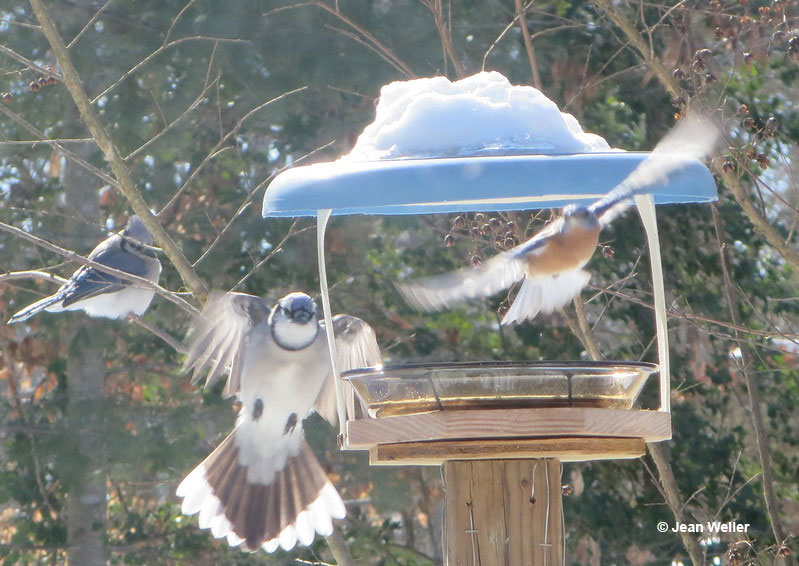
Blue Jay chasing a bluebird away from the feeder. When food sources are limited, it can become quite a challenge to get food.
Further south, in milder winter conditions, we can find farm fields with huge flocks of wintering grackles and blackbirds. Pine and Yellow-rumped Warblers also occur, and there are quite a few sparrows. A similar situation occurs along the Pacific coast and in the American Southwest.
In those regions, quite a few birds take advantage of warmer, milder conditions. In some areas, we can even find hummingbirds, and many montane birds come down from cold, high elevations. Lots of sparrows also winter in southern Arizona, and a number of birds in southern California just stay there all year long.
In many parts of North America, we also find lots of aquatic birds. There are good numbers of ducks, gulls, and loons wintering in some coastal areas and on ice-free rivers and lakes.
Do birds get cold in winter?
Birds can certainly get cold in the winter, but some species are more adapted and naturally prepared for cold weather than others.
For example, although Baltimore Orioles and Black-throated Green Warblers can withstand cool weather, they probably won’t survive for long in cold, freezing conditions. This is one of the main reasons why we don’t see these Red-eyed Vireos, and various other long-distance migrants during the winter months.
Related: Are birds warm-blooded?
Although they migrate south to winter in places with insects and other food sources, even if they had enough food in a northern winter, they just don’t have enough feathers and other adaptations to survive the cold weather.
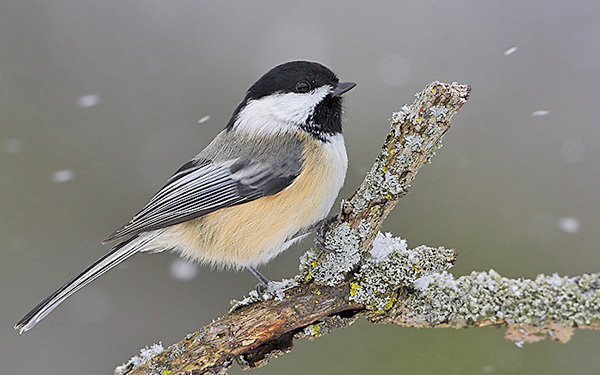
Birds usually fluff up their plumage even more in the cold. A Black-capped Chickadee is pictured here.
On the other hand, the birds we typically see during the winter months do have handy adaptations to keep them warm. Black-capped Chickadees, Downy Woodpeckers, and other hardy species have plenty of fluffy down feathers that act as natural insulation. Such plumage traps pockets of warm air that keep the bird from getting too cold.
These and other wintering bird species also keep their legs and feet warm with extra blood vessels. However, even these hardy birds can feel cold if the temperatures drop too low. To stay warm in extreme weather, they usually take refuge in tree cavities.
Can birds freeze to death?
Birds that live in regions with difficult winter weather are fairly well prepared for cold weather. They stay warm with dense plumage, fat reserves, and other adaptations. However, if the weather becomes too harsh, birds can certainly freeze to death.
Mostly, birds that succumb to cold weather are a few juvenile warblers and other inexperienced migrants that fail to migrate south. If they don’t leave by a certain date, they can get caught in low temperatures they aren’t adapted to.
Similarly, once in a rare while, Purple Gallinules and other tropical species accidentally migrate north instead of south for the winter. Such birds usually die within the first few days of freezing temperatures.
In addition to lacking adaptations to keep them warm in severe weather, such lost bird species also fail to build up their fat reserves because they can’t find enough food.
However, even resident species can freeze to death in extreme conditions. It’s not common, but tends to happen with birds more adapted to mild winters. Those would be species like the Northern Mockingbird, Carolina Wren, Tufted Titmouse, and even the Northern Cardinal. For such tragedies to occur, temperatures have to drop well below freezing but it does happen in some places, every once in a while.
What do birds feed on during the winter?
During the winter, birds feed on more types of food than a lot of people realize. Since we tend to see a lot of birds at backyard feeders, it’s easy to conclude that wintering birds eat seeds and nuts. While there is some truth to that, only certain types of birds follow that diet, and even those species can feed on other food sources.
In general, during the winter, most birds eat whatever they can find. While goldfinches and some other finches do mostly subsist on seeds, chickadees, nuthatches, and woodpeckers also pick insect eggs from branches and tree bark. These same birds, jays, and some other species won’t hesitate to feed on suet, and they’ll also eat berries.
Related: Plants that birds love
Although it might seem odd, a number of trees and bushes produce berries during the fall and winter months. In all likelihood, they probably evolved to make berries when birds would feed on them the most. After American Robins, Cedar Waxwings, and other birds eat the berries, they help propagate the plants by scattering the seeds in their droppings.
There are also wintering birds that have other, more carnivorous diets. As in summer, raptors eat small mammals and birds, and many gulls feed on garbage!
Are there more owls in winter?
In winter, it seems like we see more owls. At least that’s my impression. I go birding in summer and it’s a rare day if I can find an owl. To be honest, I don’t find all that many owls in winter either, but on average, I do see more of them.
I have wondered if there are really more owls around or if they are just easier to find. As it turns out, both of those factors come into play. In some regions, there actually are more owls at our favorite birding spots! Species like the Short-eared Owl, Long-eared Owl, and Northern Saw-whet Owl all migrate south for the winter.
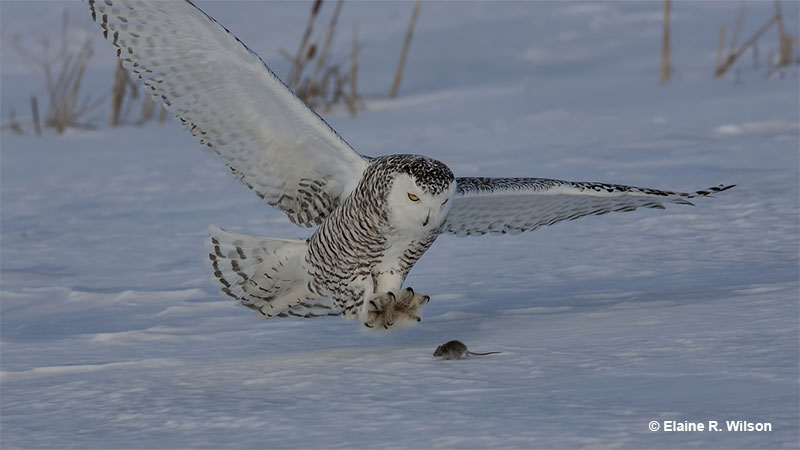
Snowy Owl mid-hunt
Some years, there are also higher numbers of owls than other years but in many parts of the northeastern USA, there are always more owls present in the winter months than spring or summer. Not to mention, Snowy Owls and rarer owl species from the north can also be around. Of course, that doesn’t mean they are easy to find!
Owls are always a challenge to see, but since there is less foliage to hide them, these nocturnal raptors are definitely a bit easier to find during the winter.
Keep reading: 15 Fun Facts About Owls
Do any birds hibernate for the winter?
Mammals, frogs, and even insects can hibernate for the winter. It’s a great strategy so why don’t birds do it too? The vast majority of birds do not hibernate because it’s easier for them to migrate to warmer climates.
Why evolve hibernation if you can just keep flying south? As it turns out, as far as some birds go, migrating is much easier than evolving the ability to hibernate.
Unlike mammals, most birds have very high metabolic rates and need to feed on a regular basis. Although they can sleep for a night, they still have to get up in the morning and find food.
That said, at least one bird has bucked this trend and another whole group of birds do something similar. While the Common Poorwill can’t hibernate in the same way as mammals, it can enter into a hibernation-like state called “torpor” for a week or more.
This nightjar species usually makes short distance migrations to regions with milder climates but can still experience cold nights. To survive such situations, it finds a crevice or other sheltered spot, and lowers its pulse and metabolic rate for several hours or days. Most nights, hummingbirds do something similar, but only for one night at a time.
Do American Robins migrate south for the winter?
We often associate American Robins with spring. That makes sense, after all, these handsome birds appear with the first warm days and sing to their heart’s content. It would seem to make sense that they are coming back from warmer places with palms and hot, sunny days.
While growing up in Niagara Falls, New York, that’s what we believed. I used to see robins singing on a pleasant March day and would know that the winter had finally come to an end! Then it would snow again a week later and we would wonder what happened!

As it turns out, while American Robins are indeed a good sign of spring, these cheerful birds do not migrate to our favorite vacation spots. In fact, they don’t necessarily migrate at all! While we might not see as many in urban areas, we will find them in rural fields and woodlands.
In winter, American Robins sometimes do migrate short distances, but most form flocks that wander through the countryside in search of crabapples and other fruiting trees. If the thrushes don’t find food, they will travel south and even out of state. However, most stay within a hundred miles of their breeding territories.
If you take down feeders in the winter, will those birds die?
This is a common concern and seems to make sense. After all, it’s cold outside, and lots of birds are at the feeders. It seems like they must depend on the food we give them. While providing birds with food can help in the winter, we’ve got to give them a lot more credit.
Those feeder birds are certainly pleased to take advantage of the abundant food, but it’s not their only food source. As long as there is habitat around, wintering birds will still be able to find food.
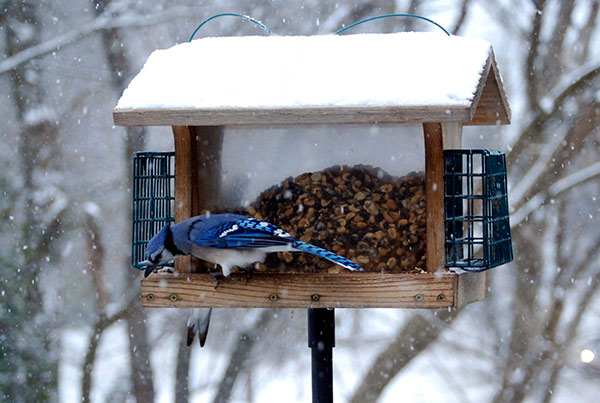
Feeders are not the only food source for birds, but they will make their lives easier.
In fact, the majority of winter birds are not foraging at feeders. Most are eating berries and seeds that they find in the wild. When goldfinches and cardinals don’t have a nice tray of sunflowers to dine on, they disperse and look for suitable habitat. In the case of goldfinches, that means weedy fields and other places with plenty of Thistle and other seeding plants.
Related: 8 reasons why birds aren’t coming to your feeders
For cardinals, foraging in winter means finding bushes with berries and other fruiting trees. It’s a similar situation for Blue Jays, Mourning Doves, and our other faithful feeder visitors. They are all adapted to finding food in the winter in the natural habitats they call home.
Do some birds stay warm by burrowing in the snow?
Snow is cold and yet it can also be insulating. It’s why Inuit peoples make igloos to stay warm during cold, northern winters. While most birds do not burrow into snow, some species have indeed learned to utilize this strategy.
The Ruffed Grouse is a chicken-like, woodland bird species highly adapted to living in cold, snowy weather. In addition to having toes with fringe-like structures that act as natural snow shoes, it can also roost in snow banks.
Although they also roost in dense conifers, when there is enough soft snow on the ground, Ruffed Grouse can fly directly into it. Then, they use their wings to create a tunnel that can be ten feet long!
The air warms up in the tunnel, and although it’s a cool 20 to 32 degrees, that’s still warmer than the ten-degree or even zero-degree temperatures of cold winter nights!
Other grouse species known as ptarmigans use a similar strategy. These Arctic and high mountain grouse dig out small caves in the snow where they spend the night and sometimes also take shelter in the day.
Redpolls also make roosting tunnels in the snow and rosy-finches may roost in snow pockets.
Does another species of goldfinch replace the American Goldfinch in winter?
In summer, bright, beautiful yellow American Goldfinches are common visitors to bird feeders. However, in winter, although goldfinches are present, we just don’t see the birds with sunshine-dipped plumage.
This stark difference sometimes makes people wonder if more than one species of goldfinch is visiting their feeders; a yellow one in summer and a duller goldfinch in the winter. Although feeders in western states can indeed have two or even three species of goldfinches, in most places, there’s only one species, the American Goldfinch.
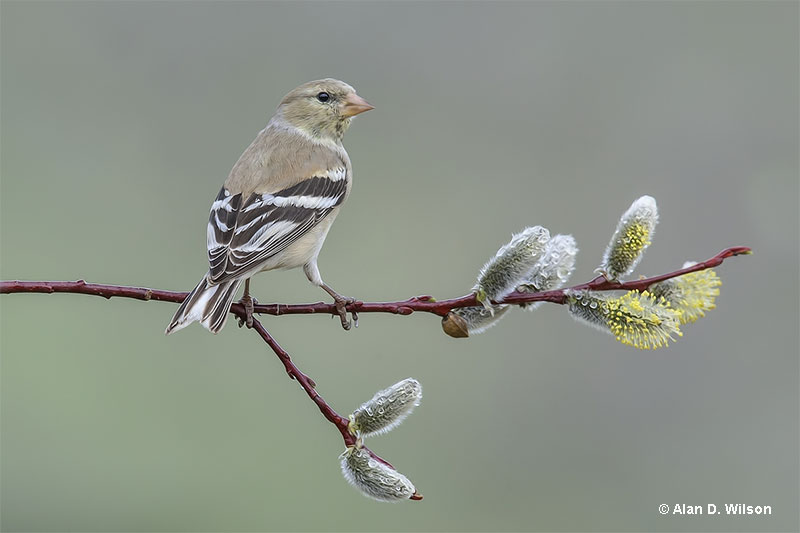
Molted American Goldfinches look similar to females.
Confusion about this bird stems from the radically different plumage shown by male birds at different seasons. In spring and summer, males are plumaged in striking, bright yellow breeding colors with a sharp little black cap, wings, and tail. Those contrasting colors make it a hard bird to miss; exactly what the males are hoping for when they see a female goldfinch.
However, in fall, the males don’t need their bright colors anymore. In fact, since they could attract the unwanted attention of predators, they molt into a much duller, pale brown plumage. This winter plumage makes them look a lot more like females and it seems as if a different, duller goldfinch is visiting the feeder.
Should you take down nest boxes in the winter?
A lot of people are convinced that nest boxes should be taken down in the winter. This idea comes from rumors and beliefs that keeping the nest box up will just attract rats and other unwanted animals. Not to mention, they don’t believe that birds are using the boxes anyways, so why not just take them down?
After the breeding season, there is a chance some other animal will make its home in the nest box, but birds also use still use them. In fact, if a Tufted Titmouse, chickadee, or other non-migratory bird nested in the box, there’s a fair chance it’s still using it in fall and winter!
These and other small birds, like nuthatches and woodpeckers survive the winter by sleeping in tree cavities. The cavities provide valuable shelter from the elements as well as good hiding spaces from owls and other predators. Since nest boxes basically perform the same function, keeping them up is an excellent way to help your backyard birds all year long.
There’s also an additional bonus to keeping nest boxes up in the winter months. If the hole is large enough, it might attract a wintering Eastern Screech or Northern Saw-whet Owl!
Do the same birds winter in the same region year after year?
Each winter, we see birds like Dark-eyed Juncos, chickadees, and cardinals at the feeder. It’s easy to wonder if we are seeing the same individuals, year after year. Although it’s near impossible to know if we are getting the same birds each winter, in all likelihood, some of those birds probably are the same ones.
As it turns out, many migrant birds winter in the same place every year. If they find a good food source, they’ll probably come back. However, there are some species that might show up one year but be absent for the next few years.
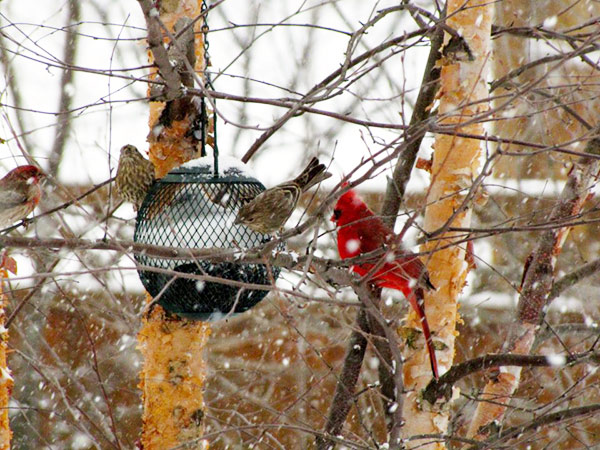
These bird species are known as “irruptive migrants” and include birds like the Evening Grosbeak, Pine Grosbeak, Bohemian Waxwing, and Snowy Owl. Regular, expected migrants like Red-breasted Nuthatches and even Dark-eyed Juncos can also be irruptive for the same reasons as the other rarer species mentioned above.
The main factor that drives all of these birds to migrate south is food. If it’s a bad year for Mountain Ash berries up north, Bohemian Waxwings and grosbeaks could turn up in the backyard! If Snowy Owls aren’t finding rodents and other food on their typical northern wintering grounds, you might see a few at a local airport!

